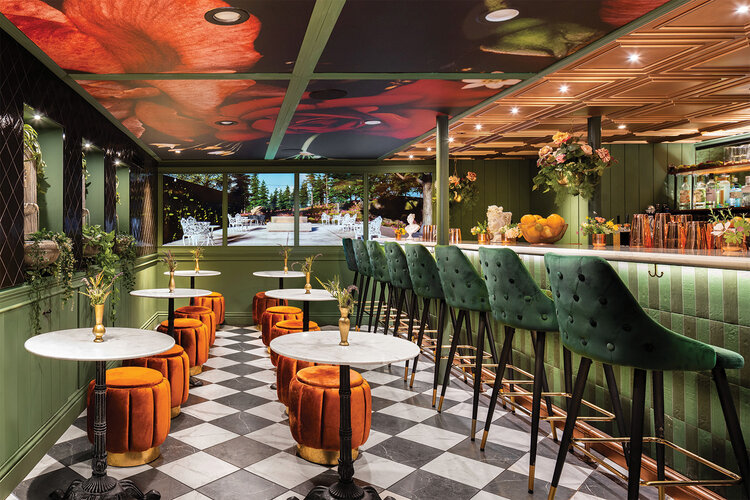In the ever-changing culinary landscape, the significance of restaurant furniture design cannot be understated. It’s more than just a place to sit; it’s a vital part of the dining experience.
As we progress through the ages, from traditional to contemporary, the evolution of restaurant furniture design becomes an enthralling journey, reflecting changing societal conventions, aesthetic choices, and technical advances.
Historical Perspective
Exploring the history of restaurant furniture design uncovers an intriguing mix of usefulness and beauty. Traditionally, furniture was chosen purely for its utilitarian use, with little regard for style or cultural significance.
However, the later part of the twentieth century saw a paradigm shift, with aesthetics taking center stage. Iconic designs from this era continue to influence modern restaurants, as they strive to combine historical charm with contemporary attraction. The cyclical nature of design trends demonstrates the timeless attraction of certain styles.
Current Landscape of Restaurant Furniture Design
Restaurant furniture design has evolved into a dynamic field, influenced by market trends and customer preferences. The modern market offers a wide range of options to suit a variety of tastes, from minimalist and Scandinavian influences to flamboyant and varied designs.
Sustainability has evolved as a guiding philosophy, with an increased emphasis on environmentally friendly materials and procedures. Technology, too, has made its mark, with smart furniture innovations improving the whole dining experience. The influence of social media adds another layer, as design decisions become not just practical but also naturally shared.
Key Elements of Modern Restaurant Furniture
Ergonomics and comfort are top priorities in modern restaurant furniture design and styles. Beyond aesthetics, the ability to establish a comfortable and inviting environment is critical to client happiness. Materials are chosen not just for their aesthetic value, but also for durability and sustainability.
Customization is encouraged, allowing restaurants to create distinct environments that reflect their brand identity. Technology integration extends beyond gimmicks to improve the dining experience with new solutions. The choice of sustainable and eco-friendly materials reflects the growing environmental concern, while a consistent design theme offers a pleasing visual experience.
Popular Styles in Modern Restaurant Furniture
In a world where first impressions are important, restaurant owners are increasingly lured to statement-making styles. Minimalistic and Scandinavian influences provide a clean and timeless style, but industrial and rustic elements convey warmth and authenticity.
Fusion styles that smoothly integrate traditional and contemporary components create a distinct and varied feel. Statement pieces and collaborations with local artists help to create dining areas that are both utilitarian and visually attractive. The investigation of various styles and cultural influences adds richness and depth to modern restaurant interiors.
Challenges and Solutions
While the pursuit of modernity in restaurant furniture design is exciting, it comes with its set of challenges. Resistance to change, whether from staff or customers, can pose obstacles. Striking a balance between aesthetics and functionality is an ongoing challenge that requires thoughtful consideration. Cost considerations and budget-friendly options are perennial concerns for restaurant owners.
However, these challenges can be navigated with a proactive approach. Regular maintenance, employee training, and open communication can mitigate resistance to change. Moreover, advancements in virtual reality and simulations offer tools for pre-implementation assessments, aiding in decision-making and problem-solving.
Future Trends in Restaurant Furniture Design
As we look to the future of restaurant furniture design, some fascinating trends emerge. Predictions point to a further integration of technology, with smart furniture possibilities growing increasingly sophisticated.
Sustainable and environmentally mindful design innovations are going to become the norm rather than a unique selling advantage. Biophilic design elements that promote a connection with nature are predicted to gain popularity.
Data analytics will increasingly influence design decisions, enabling a more personalized and focused approach. Customizable and modular furniture options will provide versatility, allowing restaurants to keep up with shifting trends. Innovative technologies, such as 3D printing, will revolutionize industry, creating new opportunities for innovation.
Designing Tomorrow: Navigating the Future of Restaurant Furniture
In the ever-changing world of restaurant furniture design, adaptability and creativity are critical components of success. The journey from historical roots to the modern landscape reveals a diverse range of styles inspired by culture, technology, and sustainability.
As the industry evolves, it is critical to stay current on market trends, customer preferences, and emerging technologies. Restaurant owners and designers alike are challenged to create rooms that not only meet guests’ basic demands but also make a lasting impact, transforming the dining experience into an artful and memorable event.
Embracing variety, while cognizant of sustainability, and encouraging creativity will definitely propel restaurants to the forefront of the ever-changing culinary world.

